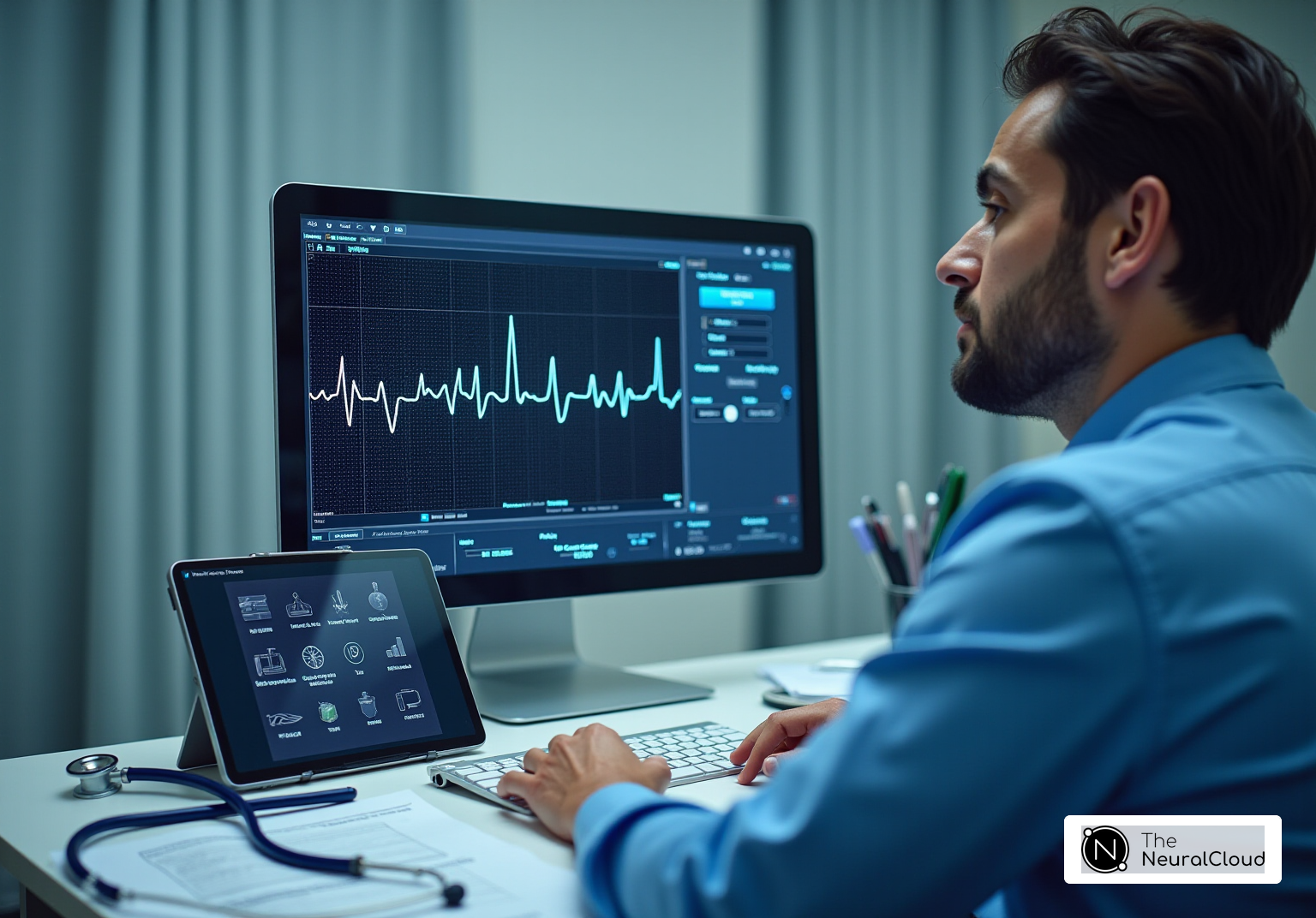Overview
The article emphasizes the significance of understanding female ECGs, detailing the preparation, procedure, and specific considerations essential for accurate cardiac assessments in women. It outlines the unique physiological factors that necessitate tailored approaches in ECG analysis. Furthermore, advancements in technology, particularly AI-driven systems, are highlighted for their role in enhancing ECG accuracy and interpretation. This progress addresses gender-specific health needs and ultimately improves overall patient care.
Introduction
Understanding the unique physiological factors that influence women's heart health is essential, as traditional ECG interpretations frequently overlook these differences. This article explores the significance of female ECGs, providing essential preparation steps and a comprehensive procedural guide tailored to the specific needs of women. Given the complexities of hormonal influences and anatomical variations, it raises an important question: how can healthcare providers ensure accurate diagnoses and effective treatments for female patients?
Define ECG and Its Importance for Women
An electrocardiogram (ECG) is a non-invasive test that records the electrical activity of the heart over time. It is essential for diagnosing various cardiac conditions, including arrhythmias and ischemic heart disease. For women, female ECGs are particularly important due to unique physiological factors that affect heart health. Women often exhibit different symptoms of heart disease compared to men, which can lead to misdiagnosis or delayed treatment. Understanding these differences is crucial for healthcare providers to ensure accurate diagnoses and effective treatment plans tailored to women's specific needs.
Additionally, studies indicate that women may experience distinct female ECG patterns, which necessitates a gender-specific interpretation of results. With the advent of like Neural Cloud Solutions, the efficiency of ECG analysis is significantly enhanced. This system utilizes advanced AI to filter noise and identify unique ECG waves, ensuring essential data is precisely captured even in difficult conditions. By integrating wearable technology, the company automates the labeling process and addresses physiological variability and signal artifacts that complicate the interpretation of female ECG.
This innovative approach revolutionizes continuous ECG monitoring. It provides healthcare professionals with actionable insights crucial for effective diagnosis and treatment. The combination of these technologies not only improves the accuracy of female ECG readings but also enhances the overall quality of care for women, ensuring that their specific health needs are met.
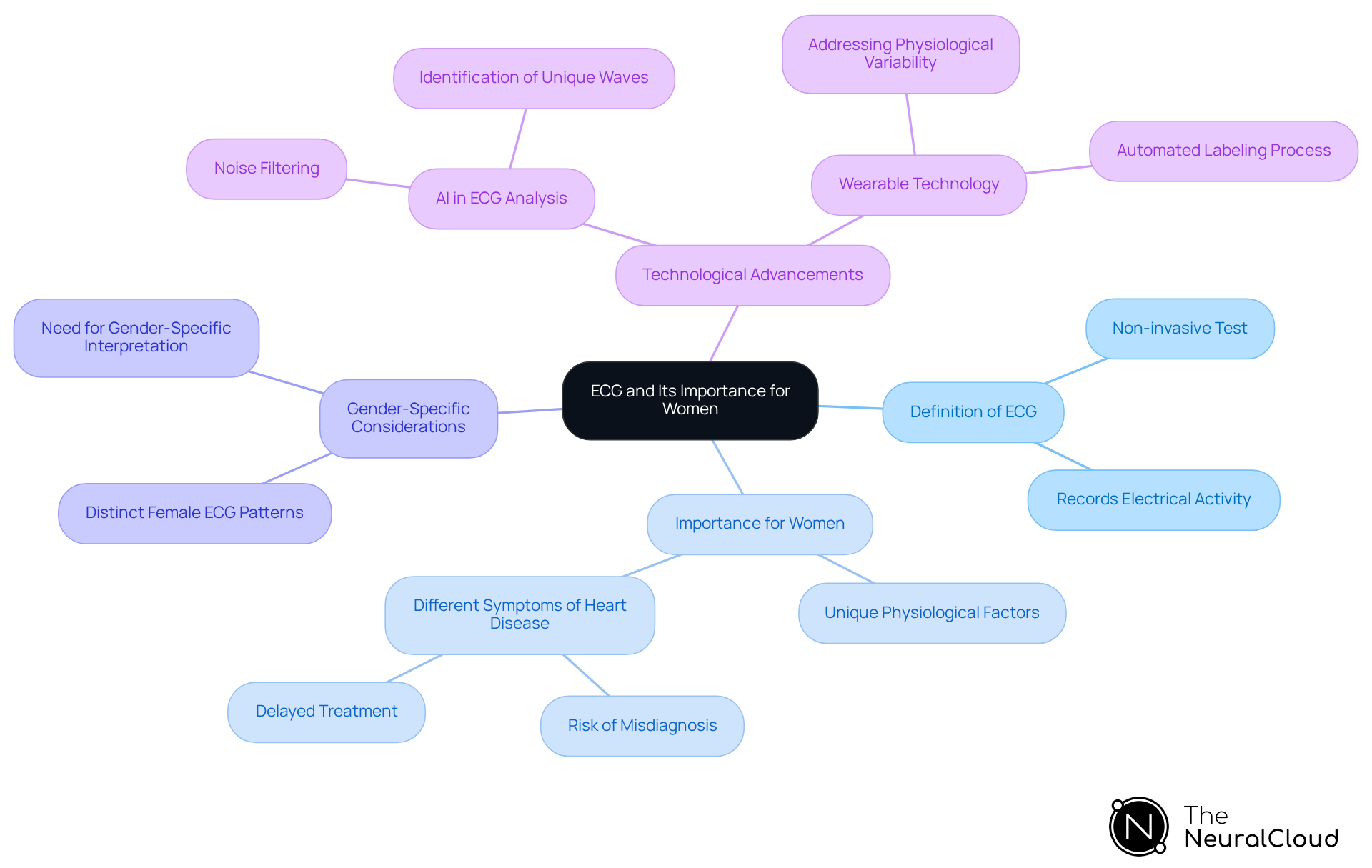
Prepare for Your ECG: Essential Steps and Expectations
Preparing for an ECG involves several essential steps to ensure accurate results and patient comfort, particularly in light of the challenges posed by physiological variability and signal artifacts. Here’s what to expect:
- Patient Communication: Explain the procedure to the patient, addressing any concerns they may have. This helps to alleviate anxiety and ensures cooperation during the test, which is crucial for minimizing movement artifacts that can affect the readings. Effective communication also enhances the ability of the system to provide precise data by ensuring the patient stays still and calm.
- Clothing and Accessories: Advise the patient to wear loose-fitting clothing that can be easily removed. Jewelry and other accessories should be taken off to avoid interference with the sensors, ensuring optimal contact and minimizing the risk of signal distortion. This preparation step is vital for the MaxYield™ platform to effectively .
- Skin Preparation: The skin at connection sites should be clean and free of lotions or oils. If necessary, shave any body hair to ensure good contact between the skin and electrodes. Proper skin preparation enhances the noise filtering abilities of the system, allowing for more precise ECG analysis.
- Positioning: The patient should lie flat on their back in a comfortable position. Ensure that they are relaxed and still during the procedure to avoid artifacts in the readings, which can complicate the interpretation process. A stable position enhances the system's effectiveness in identifying and tagging essential data.
- Environmental Factors: Ensure the room is at a comfortable temperature to prevent shivering, which can affect the ECG results. A stable environment enhances the system's capacity to provide accurate and dependable data, surpassing conventional constraints in ECG analysis.
By adhering to these preparation steps, healthcare professionals can significantly improve the effectiveness of the system, resulting in enhanced accuracy in ECG analysis.
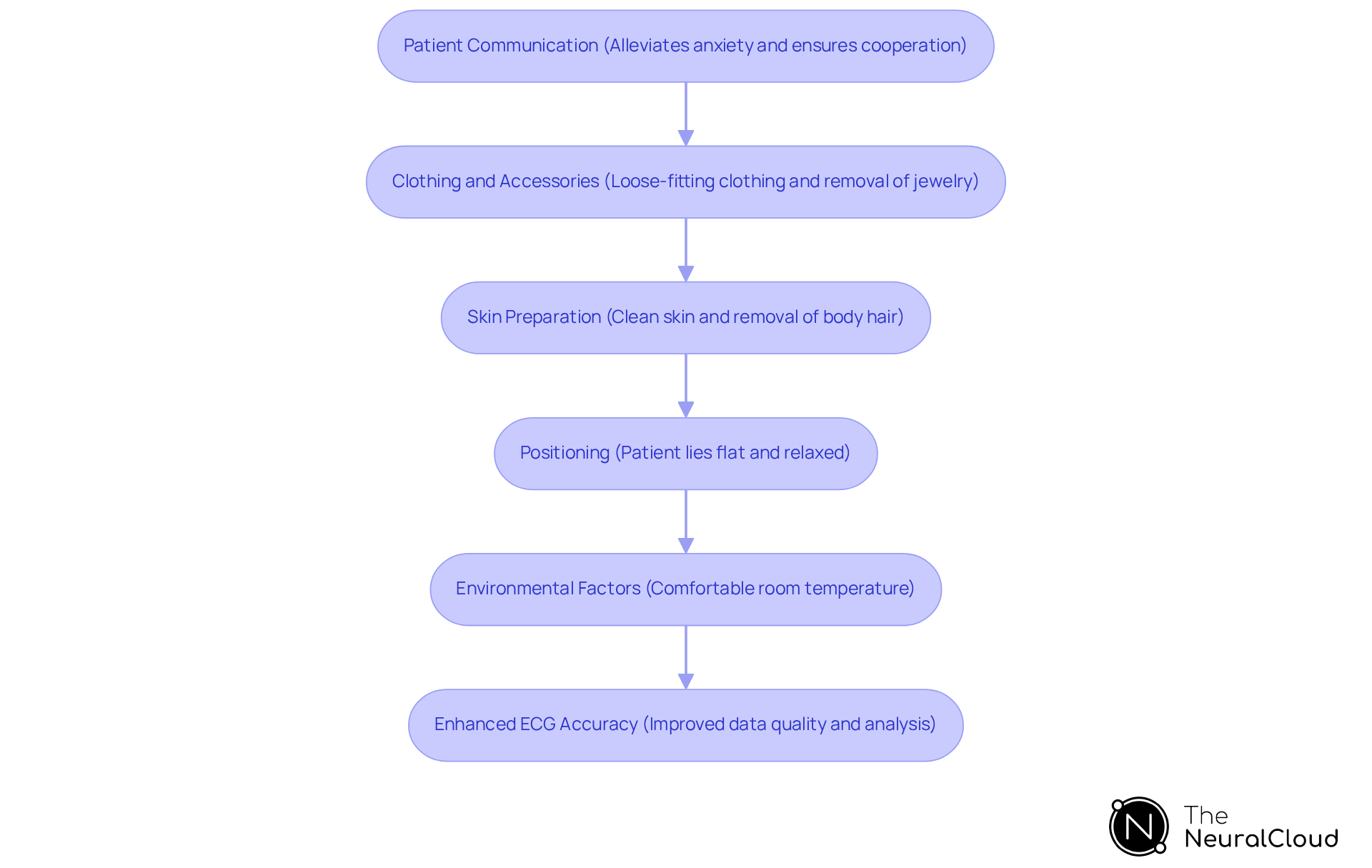
Step-by-Step Guide: Performing an ECG on Women
Conducting a female ECG on women requires meticulous attention to detail and an understanding of anatomical variations. This process can be enhanced by integrating with Neural Cloud Solutions' system. The following steps outline the procedure:
- Electrode Positioning: Position V1 and V2 in the fourth intercostal space at the right and left sternal borders, respectively. For V4, V5, and V6, place them under the breast tissue, ensuring proper contact without discomfort. The platform aids in automating the labeling process, which reduces the potential for errors during this critical step.
- Lead Connection: Connect the leads to the terminals securely and ensure they are correctly labeled to prevent confusion during interpretation. Automated annotations from MaxYield™ streamline this process, enabling technicians to concentrate on more complex decision-making tasks.
- Monitoring: After the electrodes are positioned, monitor the patient’s heart rate and rhythm on the ECG machine. It is essential that the patient remains still and relaxed during the recording. The platform's advanced algorithms filter out noise and address signal artifacts, ensuring a clear signal for accurate monitoring.
- Recording: Initiate the ECG recording, which typically lasts for about 10 seconds. Ensure that the machine captures a clear and uninterrupted signal. The system's efficiency significantly reduces the time spent on noise filtering and annotating, enhancing the overall recording process and contributing to cost reduction.
- Post-Procedure Care: Once the ECG is complete, gently remove the sensors and provide the patient with necessary aftercare instructions, including how to care for the skin where the sensors were placed. Insights gained from the MaxYield™ platform can inform better aftercare practices tailored to the physiological needs of female ECG.
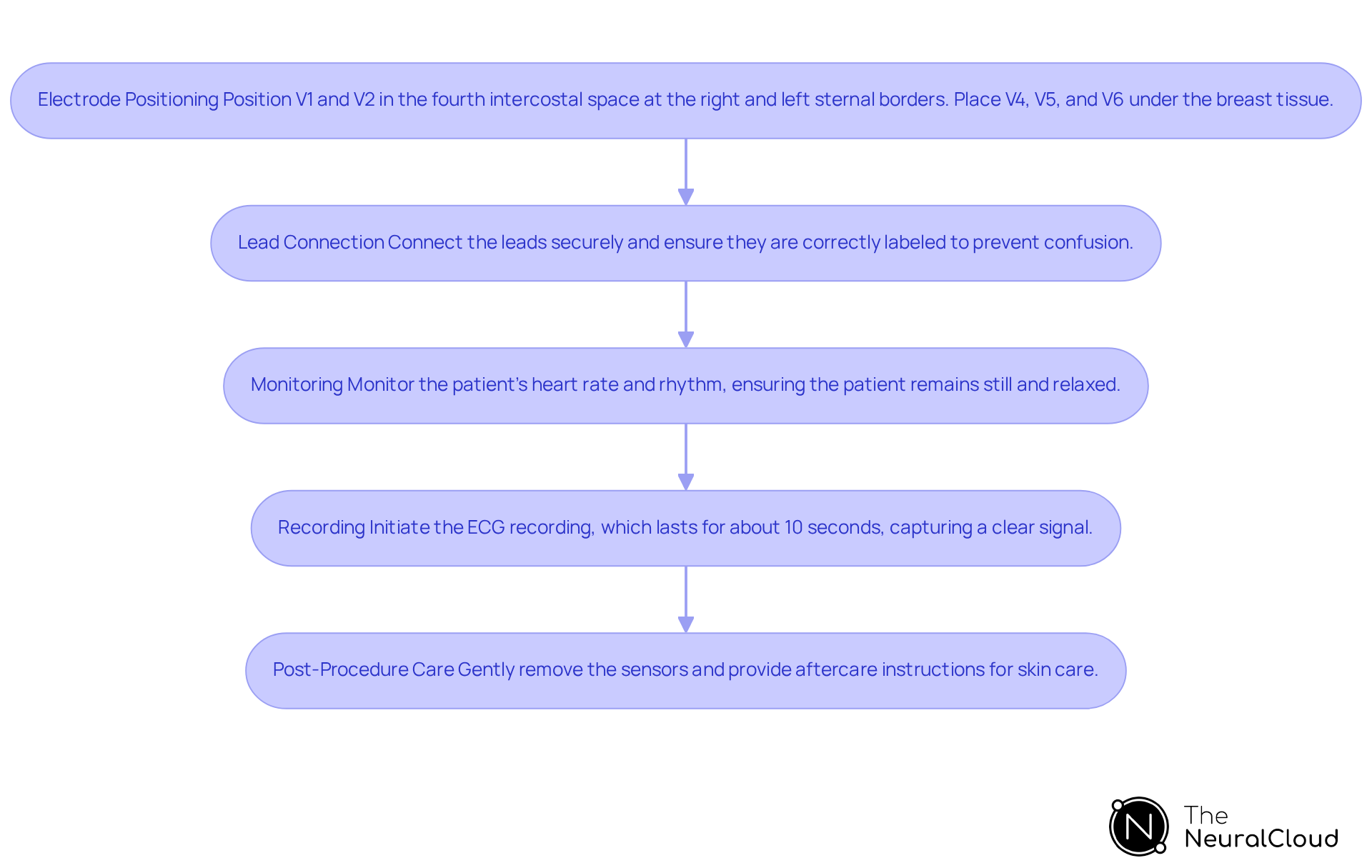
Address Special Considerations for Women During ECG
When performing ECGs on women, several special considerations must be taken into account:
- Breast Tissue: The presence of breast tissue can interfere with sensor placement. It is crucial to place sensors carefully to ensure precise readings while maintaining patient comfort. Utilizing Neural Cloud Solutions' system enhances the precision of electrode placement by providing that considers physiological variability.
- Hormonal Influences: Hormonal fluctuations can affect heart rate and rhythm, particularly during menstrual cycles or menopause. Be aware of these factors when interpreting results. The advanced AI technology in this system assists in analyzing these variations, ensuring that the readings represent true physiological states rather than artifacts.
- Anxiety and Comfort: Women may experience anxiety related to the procedure. Providing a supportive environment and clear communication can help alleviate stress and improve cooperation. The efficiency of the platform enables faster processing of female ECG data, thereby decreasing the duration patients spend in potentially stressful scenarios.
- Gender-Specific Symptoms: Women may present atypical symptoms of heart disease, such as fatigue or shortness of breath, rather than classic chest pain. This necessitates a thorough understanding of gender differences in female ECG presentations. The software aids in transforming noisy recordings into clear waveforms, allowing for better interpretation of these atypical symptoms.
- Follow-Up: Ensure that any abnormal findings are communicated effectively, and consider gender-specific follow-up care to address identified issues. The automated processes in the system streamline the analysis and enhance workflow, ensuring timely follow-up and care tailored to women's health needs. Additionally, users have reported significant cost reductions in operational expenses due to the automation features of MaxYield™, further validating its effectiveness in real-world applications.
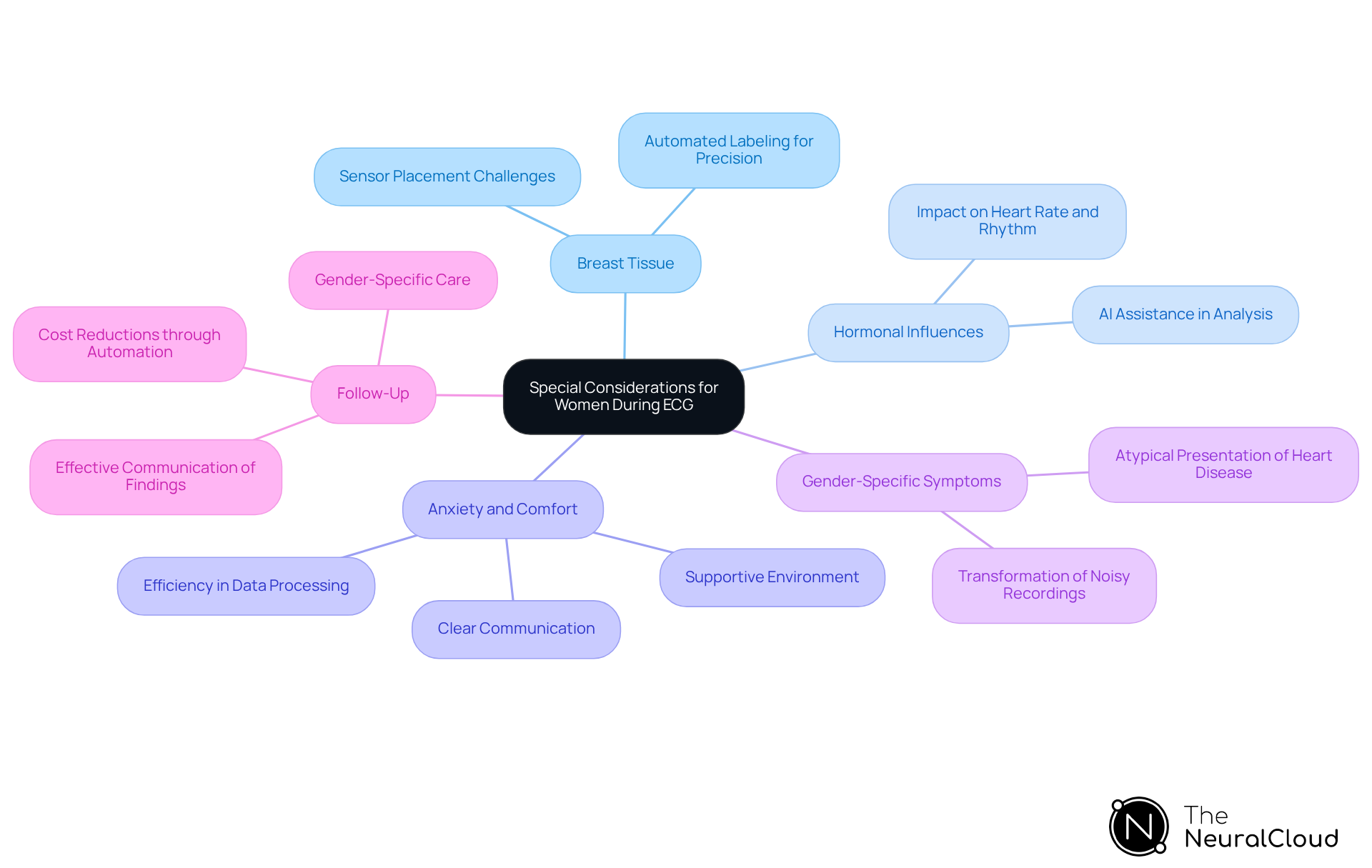
Conclusion
Understanding the significance of ECGs in women's health is vital for ensuring accurate diagnoses and effective treatment plans. Female ECGs require a tailored approach that acknowledges the unique physiological factors influencing heart health in women. By emphasizing the importance of gender-specific interpretations and utilizing advanced technologies, healthcare providers can enhance the quality of care and improve patient outcomes.
Key points discussed include:
- The preparation steps for an ECG
- The meticulous execution of the procedure
- The special considerations necessary for female patients
Effective communication, proper clothing, skin preparation, and an understanding of hormonal influences are critical to achieving accurate results. Furthermore, integrating advanced AI technology streamlines the process, allowing for precise readings and timely follow-up care.
Prioritizing women's health in ECG procedures is not only about improving diagnostic accuracy but also about fostering a supportive environment that addresses their specific needs. By embracing innovative solutions and understanding the nuances of female ECGs, healthcare professionals can significantly enhance their practice and contribute to better health outcomes for women. It is imperative to advocate for gender-specific medical practices and to continue advancing technologies that support these efforts in the pursuit of optimal heart health for all women.
Frequently Asked Questions
What is an electrocardiogram (ECG)?
An electrocardiogram (ECG) is a non-invasive test that records the electrical activity of the heart over time.
Why is ECG important for women?
ECG is essential for diagnosing various cardiac conditions, including arrhythmias and ischemic heart disease. For women, it is particularly important because they often exhibit different symptoms of heart disease compared to men, which can lead to misdiagnosis or delayed treatment.
How do women's heart disease symptoms differ from men's?
Women typically show different symptoms of heart disease than men, making it crucial for healthcare providers to understand these differences to ensure accurate diagnoses and effective treatment plans tailored to women's specific needs.
What are female ECG patterns?
Studies indicate that women may experience distinct female ECG patterns, which require a gender-specific interpretation of the results.
How does advanced technology improve ECG analysis?
Advanced technologies like Neural Cloud Solutions enhance the efficiency of ECG analysis by utilizing AI to filter noise and identify unique ECG waves, ensuring essential data is captured accurately even in challenging conditions.
What role does wearable technology play in ECG monitoring?
Wearable technology automates the labeling process of ECG data and addresses physiological variability and signal artifacts, which complicate the interpretation of female ECG.
What are the benefits of the innovative approach to ECG monitoring?
This innovative approach revolutionizes continuous ECG monitoring by providing healthcare professionals with actionable insights, improving the accuracy of female ECG readings, and enhancing the overall quality of care for women.

